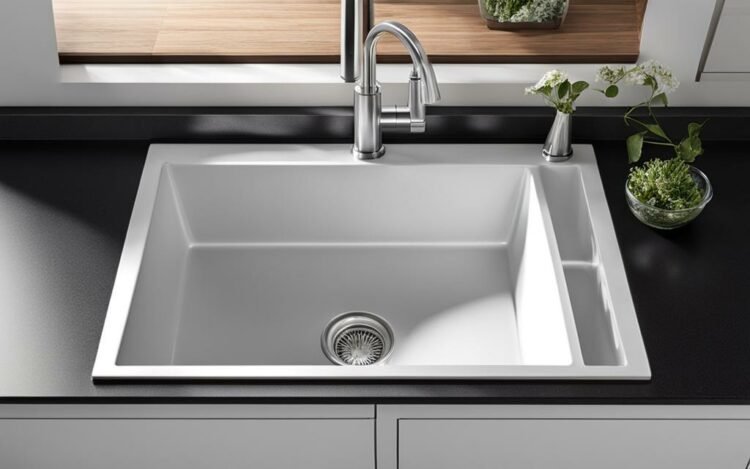The right kitchen sink material is essential for both the aesthetic appeal and functionality of your kitchen. With a wide variety of sink materials available, it can be challenging to determine which option provides the best value for money. In this guide, we will explore the different sink materials, their pros and cons, and help you make an informed decision that suits your budget and requirements.
Key Takeaways:
- Comparing Sink Materials is crucial for selecting the best option.
- The choice of kitchen sink material impacts durability, maintenance, and appearance.
- Consider factors like functionality, budget, and aesthetic appeal when choosing a sink material.
- Each sink material has its own pros and cons, so evaluate them carefully.
- Maintenance and longevity of sink materials vary, so choose one that aligns with your lifestyle.
Why Kitchen Sink Materials Matter
The choice of kitchen sink material is crucial when it comes to the overall functionality and aesthetic appeal of your kitchen. The sink material plays a significant role in determining the durability and maintenance requirements of your sink, as well as its ability to withstand heat, scratches, stains, and other forms of damage. Moreover, different materials can complement specific kitchen styles and color palettes, enhancing the overall design of your space.
When selecting the best sink material for your needs, it’s important to consider the following factors:
- Durability: Some materials, like stainless steel and fireclay, are highly durable and resistant to wear and tear. Others, such as ceramic, may be prone to scratches and chips. Assessing the durability of different materials will help you choose an option that can withstand the demands of your daily kitchen activities.
- Maintenance: Each sink material has its own maintenance requirements. Stainless steel is known for its easy cleaning and resistance to stains, while other materials may require more careful handling and cleaning. Consider your lifestyle and how much time you are willing to dedicate to sink maintenance.
- Aesthetic: The appearance of your sink can greatly impact the overall look and feel of your kitchen. Some materials, like stone composites, offer a unique and natural look, while others, such as ceramic, provide a range of design options. Choose a material that complements your kitchen style and personal taste.
Importance of Choosing the Best Sink Material
Choosing the best sink material is important because it directly affects the functionality, durability, and overall aesthetic of your kitchen sink. By understanding the different properties and characteristics of various sink materials, you can make an informed decision that meets your specific needs and preferences. Whether you prioritize durability, ease of maintenance, or visual appeal, selecting the right sink material is essential for maximizing the value and longevity of your investment.
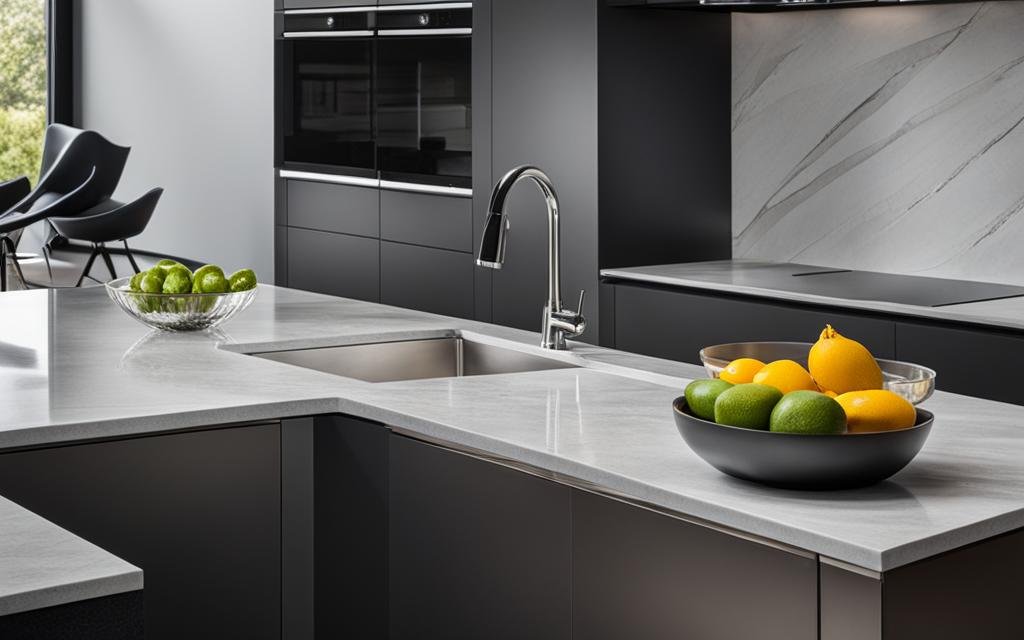
Next, we will explore a checklist for picking the best sink material, which will help you consider all the important factors and narrow down your options to find the perfect fit for your kitchen.
Checklist for Picking the Best Sink Material
Choosing the right sink material for your kitchen involves considering several factors. By following this checklist, you can narrow down your options and make an informed decision that suits your needs and preferences:
- Functionality and durability: Assess how you will be using your sink and consider the durability requirements. If you anticipate heavy usage or have a busy household, stainless steel or stone composites may be the best options due to their resilience.
- Budget range: Determine your budget and explore sink materials that align with it. Stainless steel and certain ceramics tend to be more affordable, while fireclay and stone composites may be higher in price.
- Aesthetic appearance: Consider the overall style and design of your kitchen. Different sink materials complement various kitchen styles. For a modern look, stainless steel is popular, while fireclay offers a classic and elegant feel.
- Installation and maintenance support: Evaluate the level of support you need during installation and maintenance. Some sink materials may require specialized installation, while others may be easier to maintain. Consider the manufacturer’s warranties and customer support offered.
By taking these factors into account, you can navigate the plethora of sink material options available and select the one that best meets your requirements. Keep in mind that the perfect sink material is ultimately a personal choice based on your budget, style preferences, and long-term expectations.
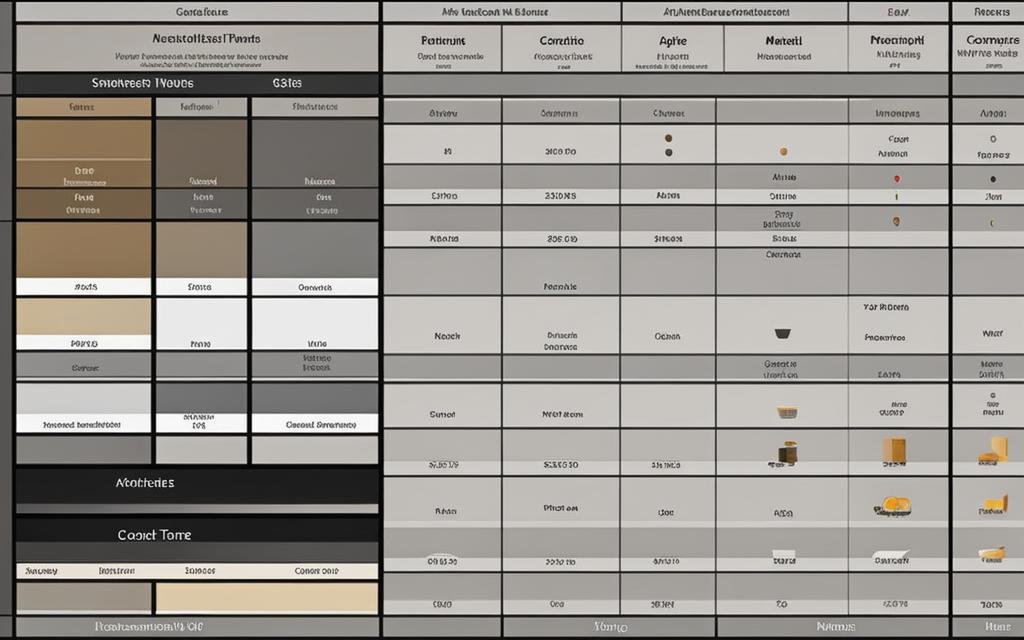
Pros and Cons of Different Sink Materials
When it comes to choosing the right sink material for your kitchen, it’s important to consider the pros and cons of each option. Here, we’ll explore the advantages and disadvantages of popular sink materials, helping you make an informed decision that suits your needs.
Stainless Steel
- Pros:
- Durable and resistant to stains, heat, and scratches
- Easy to clean and maintain
- Affordable
- Cons:
- May show water spots and fingerprints
- Can be noisy when plates or utensils are dropped
Fireclay
- Pros:
- Classic and elegant look
- Durable and resistant to stains and scratches
- Cons:
- Heavy and may require extra support during installation
- More expensive compared to other materials
Ceramic (Porcelain, Vitreous China)
- Pros:
- Affordable
- Wide range of design options
- Cons:
- Prone to scratches and chips
- May require more careful maintenance and cleaning
Stone Composites
- Pros:
- Durable and unique appearance
- Cons:
- Can be more expensive compared to other materials
By considering the pros and cons of each sink material, you can choose an option that aligns with your budget, desired aesthetic, and durability requirements. Remember to also consider factors such as maintenance and longevity, as well as the specific needs of your kitchen, to make an informed decision.
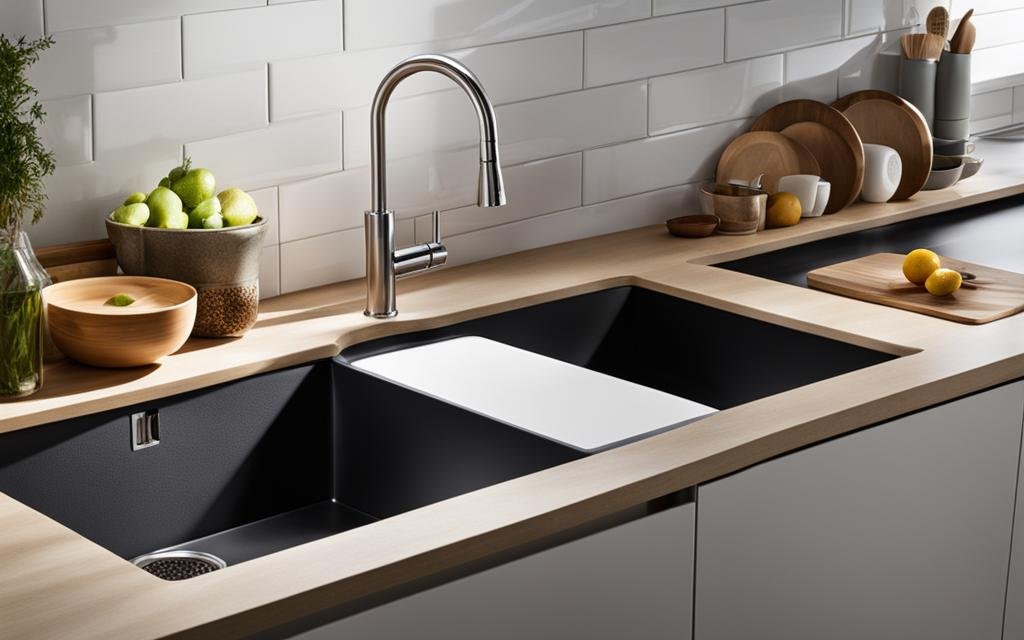
Maintenance and Longevity of Sink Materials
Proper maintenance and care are essential for ensuring the longevity and optimal performance of your chosen sink material. By following the recommended maintenance practices, you can keep your sink looking its best and extend its lifespan. Here are some tips to help you maintain and care for different sink materials:
Stainless Steel
- Regularly clean your stainless steel sink with mild soap and water, avoiding abrasive cleaners that can scratch the surface.
- Avoid leaving acidic or harsh substances, such as vinegar or bleach, on the sink for an extended period as they can cause discoloration or damage.
- Use a soft cloth or sponge to remove any water spots or stains.
- To prevent scratches, avoid using steel wool or abrasive pads for cleaning.
Fireclay
- Clean your fireclay sink regularly with a mild detergent and warm water.
- Avoid using abrasive cleaners or scrub brushes that can scratch the surface.
- Prevent heavy impact or the dropping of heavy objects onto the sink to avoid chipping or cracking.
- Consider using a protective grid or mat at the bottom of the sink to prevent scratches and marks.
Ceramic/Porcelain
- Use a non-abrasive cleaner and a soft cloth or sponge to clean your ceramic sink.
- Avoid using harsh chemicals or abrasive scrubbers that can damage the surface.
- Wipe away any water spots or stains promptly to prevent discoloration.
- Be cautious with heavy objects to prevent chips or cracks in the sink.
Stone Composites
- Clean your stone composite sink with a mild detergent and warm water.
- Avoid using abrasive cleaners or scrub brushes to prevent scratches.
- Wipe away any water spots or stains promptly to prevent residue buildup.
- Consider using a stone-specific sealer to protect the surface and enhance longevity.
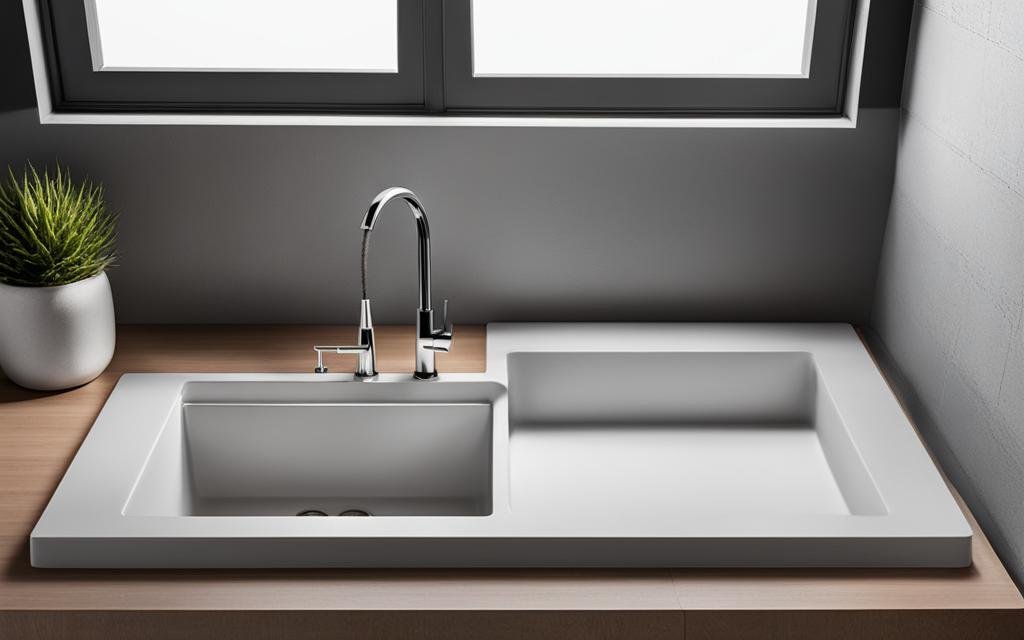
By following these maintenance practices and caring for your sink materials appropriately, you can ensure their longevity and keep them looking beautiful for years to come. Remember to always refer to the manufacturer’s instructions for specific maintenance recommendations based on the sink material you choose.
Conclusion
After considering various factors such as budget, maintenance requirements, and aesthetic preferences, you can now make an informed decision on the best sink material that provides the best value for money. By comparing the pros and cons of different sink materials, you can narrow down your options based on your specific needs.
Remember to refer to the checklist for picking the best sink material, which includes factors such as functionality, durability, desired appearance, and installation and maintenance support. This will ensure that you choose a sink material that meets your requirements and preferences.
Additionally, understanding the maintenance and longevity of each sink material is crucial for maximizing the lifespan and performance of your sink. By following proper maintenance practices and considering manufacturer warranties and support, you can ensure the longevity of your investment.
In conclusion, the best sink material is one that suits your needs, enhances the functionality and appearance of your kitchen, and offers a long-lasting investment. With the information and guidelines provided in this guide, you can confidently choose the best sink material for your kitchen that provides the best value for money.

